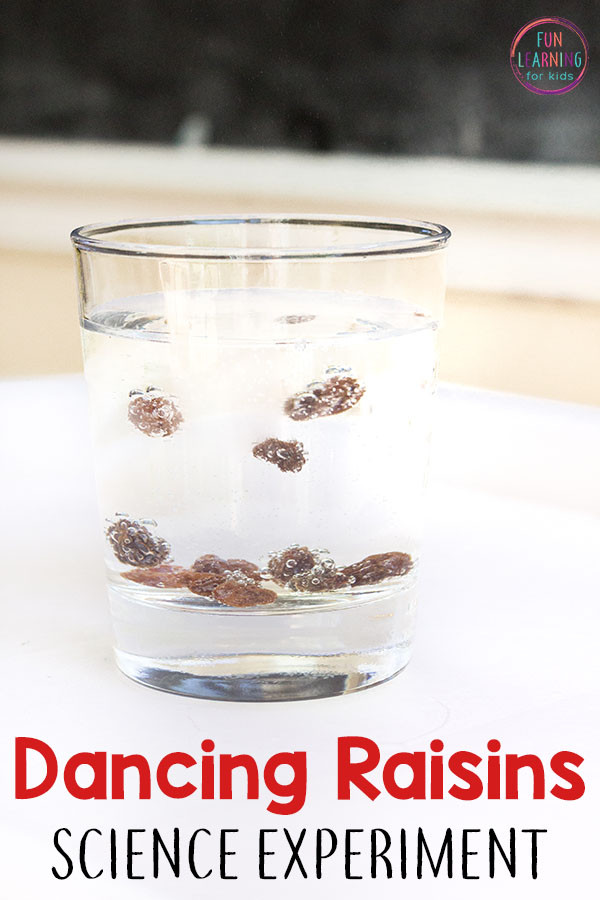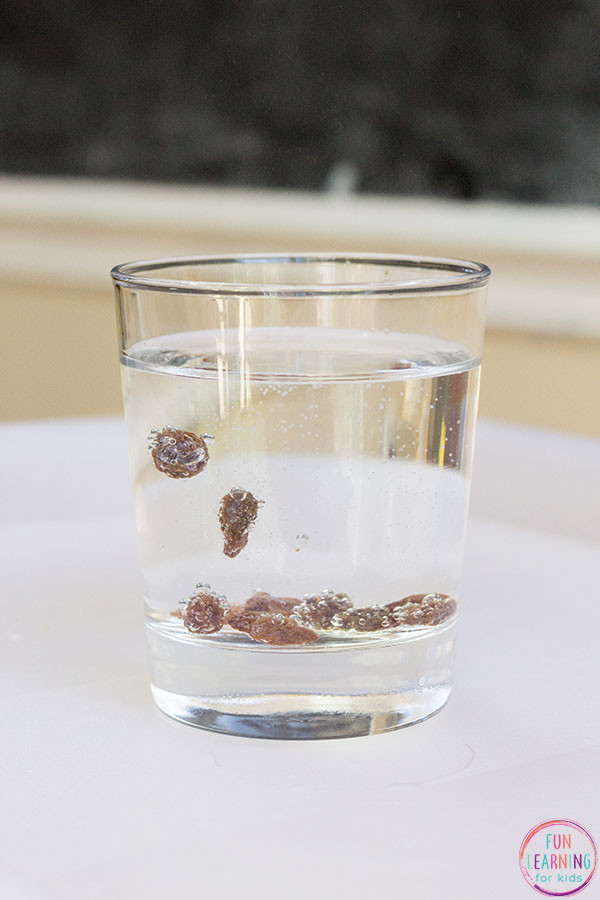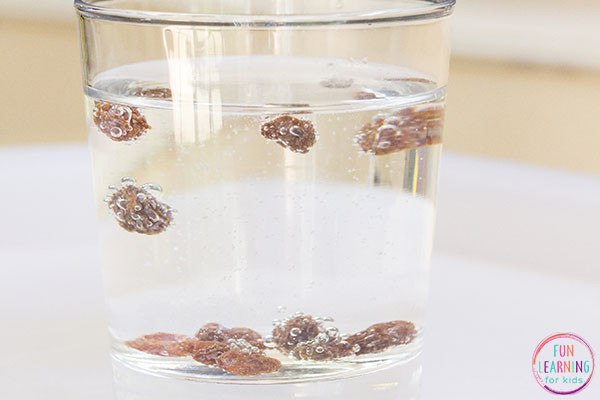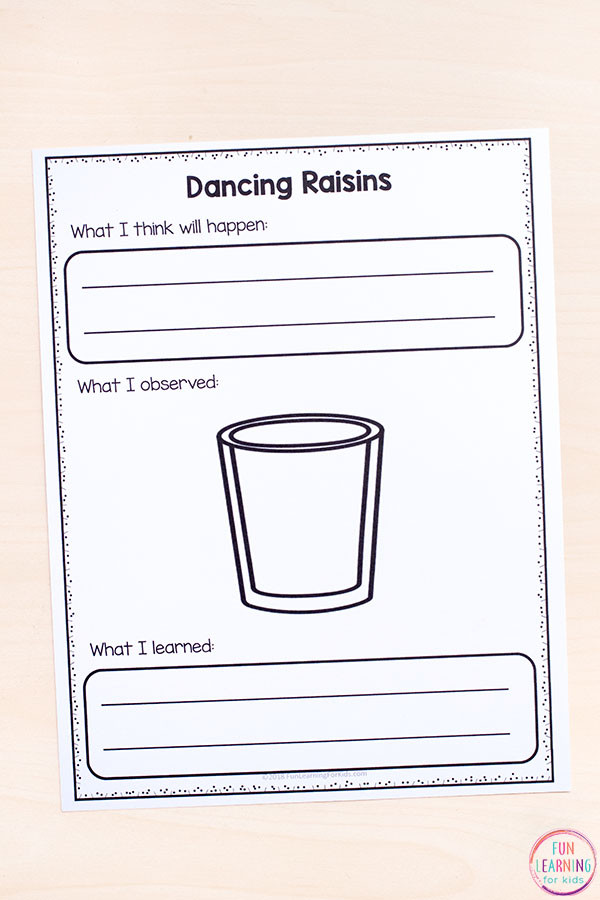Have you ever wanted to make food dance? You might think it’s magic, but it’s actually science! The Dancing Raisins experiment is a super fun and surprisingly simple science activity that will captivate kids of all ages. Using just a few household items, you can create your own raisin dance party right in your kitchen. This experiment is not only entertaining but also a fantastic way to introduce basic scientific concepts to preschoolers and elementary students. And guess what? We’ve even included free printable recording sheets to make it an educational experience too! Get ready to grab some supplies and dive into this exciting science exploration with dancing raisins!
 Close-up of dancing raisins in a glass of clear soda, a simple and fun science experiment for kids with free printable recording sheets.
Close-up of dancing raisins in a glass of clear soda, a simple and fun science experiment for kids with free printable recording sheets.
As a content creator focused on making learning fun, I’m always on the lookout for science activities that are both easy to set up and engaging for children. This dancing raisins science experiment perfectly fits the criteria! It’s incredibly simple, requires minimal preparation, and most importantly, it amazes kids. My own children were instantly fascinated by the dancing raisins, and it sparked a flurry of questions about how it all works. This curiosity became a wonderful opportunity to explain the science behind this seemingly magical movement.
Important Note: Adult supervision is always recommended when conducting science experiments with children.
The best part about the dancing raisins experiment is its simplicity. You only need two readily available supplies, and the results are truly captivating. Kids will be amazed to see the raisins moving up and down in the glass, seemingly dancing! This experiment is a fantastic visual demonstration of scientific principles in action. Keep reading to discover the science behind the dance and to download your free printable recording sheets!
Setting Up Your Dancing Raisins Experiment
This experiment is quick to set up and requires just a few items you likely already have at home.
Supplies You’ll Need:
- Clear Carbonated Soda: Club soda, 7-Up, Sprite, or any other clear, fizzy soda will work. An unopened bottle or can is ideal to ensure maximum fizziness.
- Raisins: Fresh raisins tend to work best.
Pro-Tip: Before you begin, gently separate any raisins that are clumped together. Individual raisins dance more effectively. Medium to small-sized raisins are also recommended for optimal dancing action.
Let’s Get Dancing: Step-by-Step Instructions
- Pour the Soda: Fill a clear glass with your chosen clear soda. Leave a little space at the top.
- Add the Raisins: Carefully drop a handful of raisins into the glass of soda. Before they start dancing, take a moment to observe what happens initially. Do they sink or float?
- Observe the Dance: Now, be patient and watch closely. It might take a minute or two for the dancing to begin. Get ready to witness the raisin dance!
The moment the raisins start to move is always a highlight for kids! They are usually thrilled to see the raisins rising and falling in the soda, creating a mesmerizing “dance.” Observing the bubbles clinging to the raisins and lifting them upwards is a truly cool sight.
 Side view of a clear glass filled with soda and raisins, illustrating the dancing raisins science experiment in action.
Side view of a clear glass filled with soda and raisins, illustrating the dancing raisins science experiment in action.
The Science Behind the Dance: Why Do Raisins Dance?
Want to know the secret behind the dancing raisins? It’s all about science! Let’s break down the scientific principles at play in this fun experiment.
When you first drop the raisins into the soda, they sink to the bottom. This is because raisins are denser than the soda. Density refers to how much mass is packed into a certain volume. Raisins are more compact and heavier for their size compared to the soda, causing them to sink.
However, the magic of the “dance” begins with the carbonation in the soda. Carbonated sodas are infused with carbon dioxide gas. When you pour soda into a glass, or drop raisins into it, these dissolved carbon dioxide molecules start to form bubbles.
These carbon dioxide bubbles are attracted to the rough surface of the raisins. Think of the tiny bumps and wrinkles on a raisin – these provide perfect spots for bubbles to cling to. As more and more bubbles attach to a raisin, they collectively create buoyancy.
Buoyancy Explained: Buoyancy is the upward force exerted by a fluid that opposes the weight of an immersed object. In simpler terms, it’s what makes things float. As the carbon dioxide bubbles accumulate on the raisin, the overall buoyancy of the raisin increases. Eventually, the buoyant force becomes strong enough to overcome the raisin’s weight, and the raisin rises to the surface!
Once the raisin, along with its bubble entourage, reaches the surface of the soda, something else happens. The bubbles, now exposed to the air, pop! When the bubbles pop, the carbon dioxide gas is released, and the raisin loses its added buoyancy. Without the lift from the bubbles, gravity takes over, and the raisin sinks back down to the bottom of the glass.
This process repeats as more carbon dioxide bubbles form and attach to the raisins. The raisins continue to rise and fall, creating the captivating “dancing” effect. This cycle continues until the soda loses most of its carbonation and becomes “flat,” meaning there isn’t enough carbon dioxide left to create bubbles and lift the raisins.
 Close-up shot of raisins at the bottom of a glass, illustrating the density and buoyancy principles in the dancing raisins experiment.
Close-up shot of raisins at the bottom of a glass, illustrating the density and buoyancy principles in the dancing raisins experiment.
Extend the Fun and Learning
The dancing raisins experiment is a great starting point for further scientific exploration. Here are some ideas to extend the learning and keep the fun going:
Experiment with Different Sodas: Try repeating the experiment with various types of clear sodas. Do they all work equally well? Does one soda make the raisins dance more vigorously than another? Observe and compare the results. This can lead to discussions about different levels of carbonation in various drinks.
Test Other Objects: Instead of raisins, try using other small, dense objects. Some suggestions include:
- Small pieces of uncooked pasta (like ditalini or small shells)
- Corn kernels
- Lentils
- Rice (While white rice might not work as well, you could try brown rice)
Predict which objects you think will dance and which won’t. Observe the results and discuss why some objects dance while others don’t. This can lead to a deeper understanding of surface texture and how it affects bubble attachment.
 Image of printable recording sheets for the dancing raisins experiment, designed for preschool and older students.
Image of printable recording sheets for the dancing raisins experiment, designed for preschool and older students.
Enhance the educational aspect of the experiment by using our free printable recording sheets! We’ve included two versions: one for preschool and kindergarten children that focuses on drawing observations, and another for older elementary students who can write simple sentences to record their predictions and findings. These recording sheets are a fantastic way to encourage scientific thinking and documentation skills.
 A young child happily observing the dancing raisins experiment, highlighting its appeal to kids of all ages.
A young child happily observing the dancing raisins experiment, highlighting its appeal to kids of all ages.
Explore More Exciting Science Experiments
Looking for even more fun and engaging science activities to try with your kids? We have a whole collection of simple science experiments that are perfect for young learners:
- Lava Lamp Experiment: Create mesmerizing colorful reactions with this lava lamp experiment.
- Pepper and Soap Science Experiment: Explore the fascinating concept of surface tension with the super easy pepper and soap science experiment.
- Popsicle Stick Catapult: Build a fun catapult and learn about kinetic energy with this engaging catapult activity.
- Leak Proof Bag Science Experiment: Amaze kids with the leak proof bag science experiment that seems to defy logic!
- Grow a Rainbow Science Experiment: Create a colorful rainbow using just markers, a paper towel, and water with this grow a rainbow experiment.
- Rain Cloud Jar Science Experiment: Learn about clouds and rain in a visually engaging way with the rain cloud jar science experiment.
The dancing raisins experiment is a fantastic, easy, and memorable way to introduce kids to the wonders of science. Give it a try and watch the amazement and curiosity unfold!
